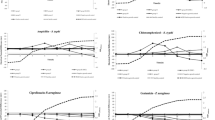Abstract
Pseudomonas aeruginosa is a gram-negative bacterium, considered one of the most common causes of nosocomial infections. Bacterial cultures produce an exchange of energy as a result of their metabolism. The rate of heat production is an adequate measure of the metabolic activity of the organisms and their constituent parts. Micro-organisms produce small amounts of heat, in the order of 1–3 pW per cell. Although the heat produced by bacteria is very small, their exponential reproduction in a culture medium permits heat detection through microcalorimetry. In this work, we analysed the microcalorimetric behaviour of P. aeruginosa and its susceptibility against two antibiotics: ceftazidime and piperacillin–tazobactam. We performed this experiment five times using different concentrations of antibiotics (2 × MIC, 1 × MIC, 0.75 × MIC, 0.5 × MIC y 0.25 × MIC). The effect of antibiotics on bacterial growth can be evaluated by the delay of heat flow and reduction of the heat flow peak compared to results with the growth control without the presence of antibiotics. The measures were carried out using a Calvet microcalorimeter that contains two stainless steel cells of approximately 10 cm3 (reference and experimental). A constant temperature of 309.65 K was maintained within the microcalorimeter. Recording the difference in calorific potential over time, we obtained the growth curves of P. aeruginosa.











Similar content being viewed by others

References
Murray P, Rosenthal K, Pfaller M. Microbiología médica. 6ª ed. Amsterdam: Elsevier; 2009.
Forbes B, Sahm D, Weissfeld AB. Diagnóstico microbiológico. 12ª ed. Madrid: Médica- Panamericana; 2007.
Lago N, Legido JL, Paz-Andrade MI, Arias I, Casás LM. Microcalorimetric study on the growth and metabolism of Pseudomonas aeruginosa. J Therm Anal Calorim. 2011;105(2):651–5.
Vázquez C, Iglesias TP, Mourelle L, Gómez CP, Lago N, Mato MM, et al. Ultrasonic bacterial treatment of mineral waters. A study on S. epidermidis, S. warneri, P. aeruginosa and P. mirabilis. Environ Earth Sci. 2014;. doi:10.1007/s12665-014-3488-y.
Ma J, Qi WT, Yang LN, Yu WT, Xie YB, Wang W. Microcalorimetric study on the growth and metabolism of microencapsulated microbial cell culture. J Microbiol Methods. 2007;68:172–7.
Trampuz A, Salzmann S, Antheaume J, Daniela AU. Microcalorimetry: a novel method for detection of microbial contamination in platelet products. Transfusion. 2007;47:1643–50.
Braissant O, Wirz D, Göpfert B, Daniels AU. Biomedical use of isothermal microcalorimeters. Sensors. 2010;10:9369–83.
Liang H, Wu J, Liu Y, Yang L, Hu L, Qu S. Kinetics of the action of three selenides on Staphylococcus aureus growth as studied by microcalorimetry. Biol Trace Elem Res. 2003;92:181–7.
Wang X, Liu Y, Xie B, Shi X, Zhou J, Zhang H. Effects of nisin on the growth of Staphylococcus aureus determined by a microcalorimetric method. Mol Nutr Food Res. 2005;49:350–4.
Xu XJ, Chen C, Wang Z, Zhang Y, Hou A, Li C. Antibacterial activities of novel diselenide-bridged bis(Porphyrin)s on Staphylococcus aureus investigated by microcalorimetry. Biol Trace Elem Res. 2008;125:185–92.
Yan D, Han YM, Wei L, Xiao XH. Effect of berberine alkaloids on Bifidobacterium adolescentis growth by microcalorimetry. J Therm Anal Calorim. 2009;95(2):495–9.
Kong W, Li Z, Xiao X, Zhao Y, Zhang P. Activity of berberine on Shigella dysenteriae investigated by microcalorimetry and multivariate analysis. J Therm Anal Calorim. 2010;102:331–6.
Luo JY, Yang MH. Demetoxycurcumin. A potential antimicrobial agent. J Therm Anal Calorim. 2014;115(3):2331–8.
Shen XS, Liu Y, Zhou CP, Zhao RM, Qu SS. Microcalorimetric study on the antibiotic activity of clarithromycin and erythromycin. Wuhan Univ J Nat Sci. 2000;54(1):215–8.
Von Ah U, Wirz D, Daniels AU. Isothermal microcalorimetry: a new method for MIC determinations: results for 12 antibiotics and reference strains of E. coli and S. aureus. BMC Microbiol. 2009;. doi:10.1186/1471-2180-9-106.
Tafin U, Majic I, Zalila C, Betrisey B, Corvec S, Zimmerli W, Trampuz A. Gentamicin improves the activities of daptomycin and vancomycin against Enterococcus faecalis in vitro and in an experimental foreign-body infection model. Antimicrob Agents Chemother. 2011;55(10):4821–7.
Howell M, Wirz D, Daniels AU, Braissant O. Application of a microcalorimetric method for determining drug susceptibility in Mycobacterium species. J Clin Microbiol. 2012;50(1):16–20.
Wang CY, Xu F, Sun LX, Sun YJ, Qiu SJ, Zhao ZB, et al. Influences of levofloxacin salts on the metabolism of Escherichia coli by microcalorimetry. J Therm Anal Calorim. 2012;. doi:10.1007/s10973-012-2426-z.
Entenza JM, Bétrisey B, Manuel O, Giddey M, Sakwinska O, Laurent F, et al. Rapid detection of Staphylococcus aureus strains with reduced susceptibility to vancomycin by isothermal microcalorimetry. J Clin Microbiol. 2014;52(1):180–6.
Verdes PV, Mato MM, Paz Andrade MI, Legido JL. Contribution to study of the thermodynamics properties of mixtures containing 2-methoxy-2-methylpropane, alkanol, alkane. J Chem Therm. 2014;73:224–31.
Vázquez C, Lago N, Legido JL, Arias I, Casás LM, Mato MM. Microcalorimetric study of the growth of Enterococcus faecalis, Klebsiella pneumoniae and their mixtures in an enriched cultura medium. J Therm Anal Calorim. 2013;113(3):1415–20.
Vázquez C, Lago N, Mato MM, Casás LM, Esarte L, Legido JL, et al. Microcalorimetric performance of the growth in culture of Escherichia coli, Proteus mirabilis and their mixtures in different proportions. J Therm Anal Calorim. 2014;116(1):107–12.
Lago N, Legido JL, Casás LM, Arias I. Microcalorimetric study of the growth of Enterococcus faecalis in an enriched culture medium. J Therm Anal Calorim. 2012;108:665–70.
Braissant O, Wirz D, Göpfert B, Daniels AU. Use of isothermal microcalorimetry to monitor microbial activities. FEMS Microbiol Lett. 2010;303:1–8.
Acknowledgements
We thank María Perfecta Salgado Gonzalez and Sofia Baz Rodríguez for their collaboration with the technical measures. We are also thankful for the financial support provided by the projects EM 2012/141, CN 2012/285, and “Agrupación Estratégica de Biomedicina (INBIOMED)” by “Xunta de Galicia” and the project FIS 2011-23322 funded by Ministry of Science and Innovation of Spain. All these projects are co-financed with FEDER funds.
Author information
Authors and Affiliations
Corresponding author
Rights and permissions
About this article
Cite this article
Esarte López, L., Lago Rivero, N., Vázquez, C. et al. Microcalorimetric method to determine ceftazidime and piperacillin–tazobactam susceptibility in Pseudomonas aeruginosa . J Therm Anal Calorim 121, 353–360 (2015). https://doi.org/10.1007/s10973-015-4685-y
Received:
Accepted:
Published:
Issue Date:
DOI: https://doi.org/10.1007/s10973-015-4685-y



